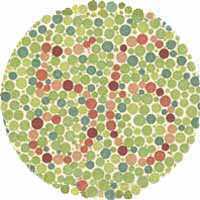The commonly used test for color blindness is the Ishihara Test - testing the ability of athletes to distinguish colors.
equipment required: The full Ishihara Test is a collection of 38 plates filled with colored dots. The dots are colored in different shades and a number is hidden inside with shades of another color.
procedure: Subjects look at each plate of the 38 plates and have to indicate the number or shape illustrated. It is usually not necessary to conduct the full test, as a color vision deficiency is usually apparent after just a few plates.
results: Between 10-20% of males have some degree of color blindness, and only a small percentage of females. Red-Green Color blindness is the most common.
treatment: There is no treatment for color blindness, though colors can be chosen that limit the possibility of confusion for color blind individuals.
comments: This test was developed by the Japanese ophthalmologist Shinobu Ishihara (1879-1963), who developed this test at at the Military Medical School to screen military recruits for abnormalities of color vision.
Related Pages
- More health tests, including more on vision testing
- vision testing for athletes, color blindness and eye dominance testing for athletes.
- Health Tests for Athletes


 Current Events
Current Events